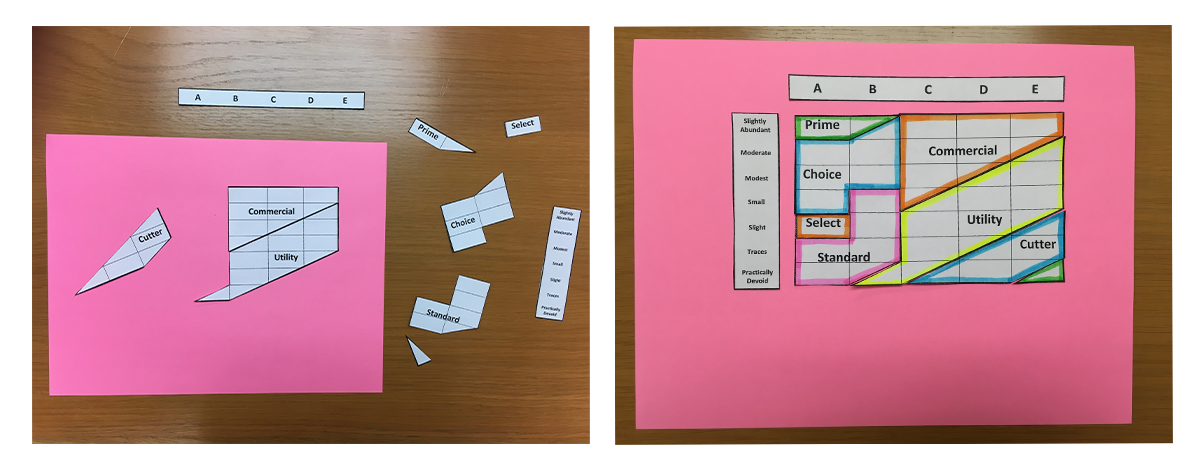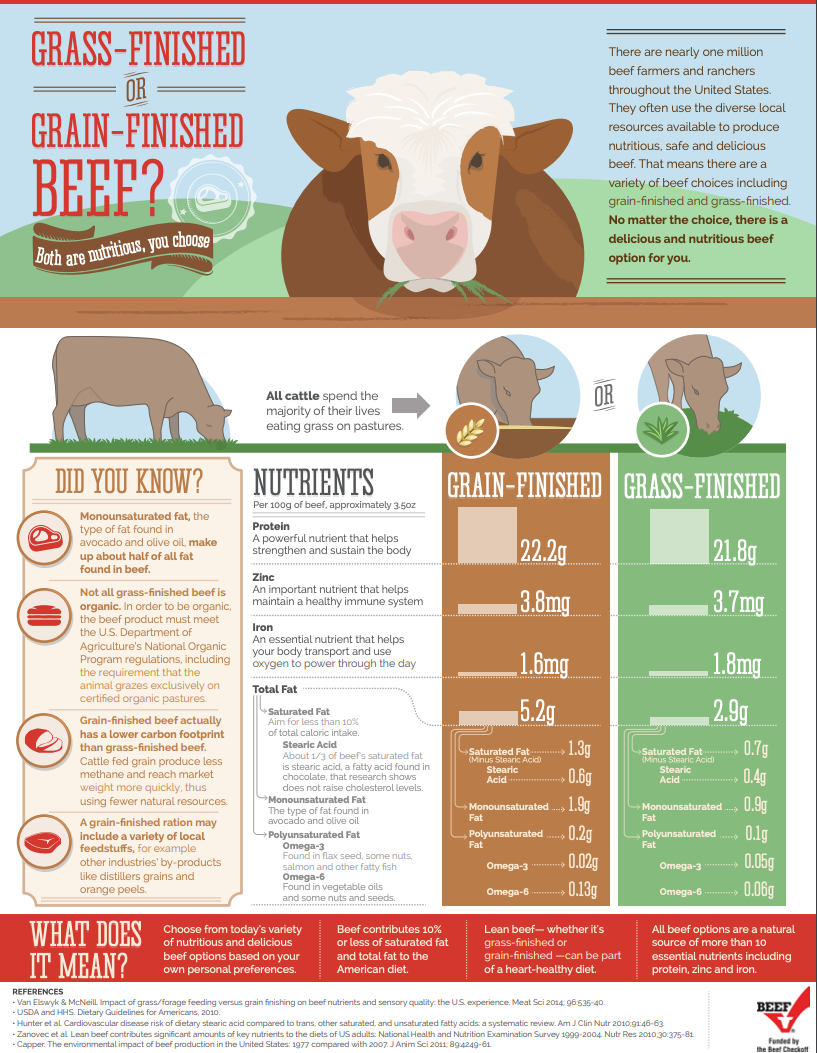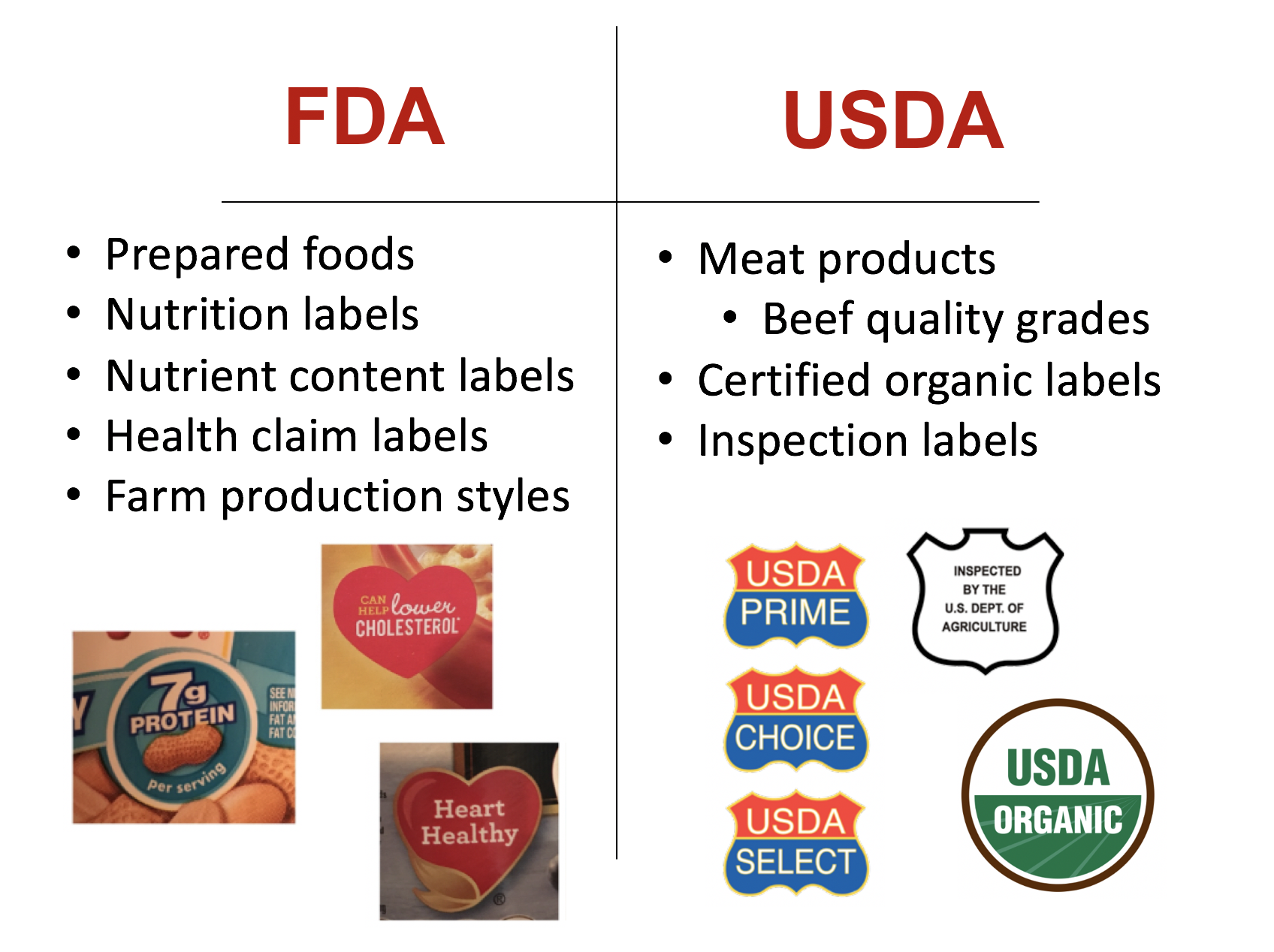Lesson Plan
Beef: Making the Grade
Grade Level
Purpose
Students will evaluate the USDA grading system for whole cuts of beef and discuss consumer preferences and nutritional differences between grain-finished and grass-finished beef. Students will also distinguish various labels on beef products and discuss reasons for the government’s involvement in agricultural production, processing and distribution of food. Grades 9-12
Estimated Time
Materials Needed
Engage:
- Scissors
- Glue sticks
- USDA Quality Grade Puzzle, 1 copy per student
- Grading Beef PowerPoint slides
- Blank piece of cardstock/construction paper, 1 per student
- Colored pencils or markers (optional)
Activity 1: Grading Beef
- Completed USDA Quality Grade Puzzle (from Engagement)
- Grading Beef PowerPoint slides
Activity 2: Grain-finished vs. Grass-finished
- Grading Beef PowerPoint slides
- Beef Labels handout, 1 copy per student
- Grass-finished or Grain-finished beef? infographic
Activity 3: Labeling Regulations: Who's in Charge?
- Grading Beef PowerPoint slides (cont'd)
Vocabulary
concentrate: animal feed that contains low amounts of fiber and high amounts of energy
finishing weight: the weight cattle reach (usually between 1,200 and 1,500 pounds) when they are ready for harvesting
forage: bulky food such as grass or hay typically consumed by livestock
grain: the edible seed or seed-like fruit of grasses that are cereals (such as wheat, corn, and rice)
harvest: to kill or slaughter an animal for human use
marbling: the white streaks of fat found within the meat
regulate: control or supervise by means of rules and regulations
United States Department of Agriculture (USDA): a federal agency responsible for developing and executing federal laws related to farming, forestry, and food
USDA quality grade: a grade given to whole cuts of beef based on the age of beef and degree of marbling
weaning: when a young mammal no longer receives milk from its mother
Did You Know?
- U.S. farmers and ranchers produce 18% of the world’s beef with only 8% of the world’s cattle.1
- Monounsaturated fat—the fat found in avocados and olive oil—makes up about half of all fat found in beef. 2
- Not all grass-finished beef is organic. In order to be organic, the beef must meet the USDA’s organic regulations which requires cattle to exclusively graze on certified organic pastures.2
- Grain-finished beef has a lower carbon footprint than grass-finished beef. Cattle that are fed grain produce less methane and reach market weight more quickly, thus using fewer natural resources. 2
Background Agricultural Connections
Beef can be found on dinner tables and in restaurants worldwide. As consumers select beef entrées from a menu or purchase steaks at the grocery store, they may see a wide variety of product labels and beef terminology that raise questions. What does USDA Prime mean? Why is this steak more expensive than the others? Do I want grass-finished beef or grain-finished beef?
There are many factors to consider when purchasing beef, including the USDA quality grade and food production system labels. When there is a high demand for a specific type of beef, cattle ranchers typically produce products that meet consumer needs and preferences. Following consumer demand, some cattle producers choose to raise their cattle following the requirements to label the beef as "organic." Other cattle producers might raise grass-fed beef for consumers who prefer lean meat. It is important for consumers to understand each of these factors so they can make informed decisions and select beef that meets their needs.
USDA Quality Grade
Whole cuts of beef are given a quality grade by USDA meat graders. Quality grades act as a language within the beef industry and are based off of the degree of marbling found within the meat, as well as the age and maturity of the beef.
- Prime: Prime beef comes from young cattle who are well-fed. The meat has abundant marbling and can typically be found in restaurants and hotels.
- Choice: Choice beef is considered high quality, but has less marbling than Prime. Roasts and steaks from the rib and loin will be very juicy, tender, and full of flavor.
- Select: Select beef is leaner than Prime and Choice. It may still be tender, but will lack flavor and juiciness due to less marbling. It is suggested that many Select cuts should be marinated before cooking to maximize flavor.
- Standard and Commercial: Standard and Commercial grade beef is typically sold as ungraded or store brand meat.
- Utility and Cutter: Utility and Cutter beef is rarely sold at retail, but can be used to make ground beef and other processed products.
Grass-finished Beef vs. Grain-finished Beef
Some consumers have an increased interest to know how cattle were fed before the beef was harvested. Grass-fed or grass-finished labels can be found on beef products in grocery stores. Grain-fed labels do exist; however, they are typically not put on beef packages because most beef is raised that way. What most consumers don’t realize is that all cattle spend the majority of their lives eating grass and forage products. Calves are raised with their mother on pasture or grass until they are between 6-12 months of age. After weaning, cattle are then fed to a finishing weight for harvesting. This is where cattle will be considered either grass-finished or grain-finished. Grass-finished cattle take longer to reach a finishing weight; however, it is cheaper to raise cattle on grass and pasture rather than feeding grain. Without grain and concentrates in the diet, the meat will be leaner. Some consumers prefer meat that is lean and less fatty. Cattle that are finished on a grain diet fatten up and reach a finishing weight faster than grass-finished cattle. The marbling that comes from a grain diet makes a steak juicy, tender, and flavorful. Meat that is graded USDA Prime, USDA Choice, or USDA Select are typically more expensive because they have the most marbling. There are slight nutritional differences between grass-finished beef and grain-finished beef; however, all beef is packed with protein and a 3-oz serving of either kind will supply consumers with 50% of their recommended Daily Value of protein.1 Grass- and grain-finished beef are both nutritious, and consumers should purchase meat that best fits their needs and preferences. 
Farm Production System Labels
Production system labels used on beef products indicate how cattle were raised and fed before harvesting. Organic and Naturally Raised labels are commonly found among grass- and grain-finished beef products. Consumers should make sure that organic beef includes the green and white “USDA Organic” label. Refer to the Decoding Labels infographic produced by the Beef Council for specifications of each label.

Image from Decoding the Label: Know Your Beef Choices created by the Beef Council
Engage
- Project slide one from the Grading Beef PowerPoint on the board.
- Ask students the following questions to lead a class discussion:
- Do cattle really receive grades?
- What kind of grades do we give beef cattle?
- How do grades affect consumers?
- Pass out a USDA Quality Grade Puzzle to each student or each pair of students.
- Instruct students to cut out each of the puzzle pieces.
- Have each student or pair of students race to put the puzzle together.
- Instruct students to glue their puzzle together onto the blank sheet of paper. Students may also color-code each section on the scale for easier reading. (A-E should be placed above the scale, and the degrees of marbling should be placed to the side of the scale.)
- Ask students to examine the puzzle once they are finished. Ask the following questions to lead a class discussion:
- What are the words on the puzzle referring to?
- Have you noticed any of these words somewhere? Try to lead students to recall seeing “prime” and “choice” in a restaurant or grocery store.
- Inform students that they are going to use this puzzle (grading scale) to learn more about the beef they eat and how cuts of meat receive grades.

Explore and Explain
Activity 1: Grading Beef
- Explain to students that after cattle are harvested, the carcass and whole cuts of meat are given a grade. Ask students the following questions:
- How is the scale used to grade beef?
- Why is beef graded?
- What factors affect the grade given to cuts of meat?
- Explain to students that in order to be harvested, cattle should be fed to a specific weight. This is called a finishing weight. When the meat is harvested, meat inspectors will grade the beef based on two things: maturity (age) of the beef carcass and how much marbling it has. Columns A through E on the chart refer to the age of beef and rows slightly abundant through practically devoid refers to the amount of marbling.
- Instruct students make note of the following beef ages on their puzzles:
- A: 9-30 months
- B: 30-42 months
- C: 42-72 months
- D: 72-96 months
- E: >96 months
- Ask students the following questions to lead a class discussion:
- What is marbling?
- What causes marbling?
- Project the Grading Beef slide (slide two) on the board.
- Ask students to compare the degree of marbling in each of the photos.
- Using the next six slides, instruct students or pairs of students to grade each photo based on its age and the degree of marbling. Allow students to use their puzzles to determine the quality grades of each photo.
- Once students have determined a grade for a photo, have them place the corresponding number on their puzzles where it belongs. (Each photo is numbered.)
- Discuss students’ results on each slide.
Activity 2: Grain-finished vs. Grass-finished
- Ask students how the diet of cattle could affect the USDA grade.
- Allow students to brainstorm possible answers.
- Project the Beef Labels slide (slide nine) from the PowerPoint on the board.
- Explain to students that many of the labels they see on beef packages give consumers an idea of how that beef was fed and raised.
- Pass out a Beef Labels handout to each student.
- Ask students to examine each of the labels and write their own interpretations of each label.
- What kind of diet did this animal have?
- How was it raised?
- What does this label mean?
- Discuss each of the labels with students and their interpretations.
- Project the next four slides (10-13) on the board.
- Ask students to write the facts about each label below their interpretations.
- Were any of their interpretations correct?
- What surprised students about the label facts?
- What did students assume about the diet of cattle from beef labeled organic or natural?
- Is all grass-fed beef considered organic?
- Can grain-fed cattle be organic?
- Project the Cattle Lifecycle slide (slide 14) on the board. Point out to students that all cattle spend the majority of their lives eating grass, but they can be fed (finished) differently to reach a harvesting weight.
- Ask students to make a connection between the diet of cattle and USDA grades.
- After students have brainstormed possible answers, refer to the Background Agriculture Connection paragraph to discuss the questions below:
- Does grain or grass produce more marbling?
- Why are Prime and Choice cuts of beef more expensive?
- Ask students to create a T-chart comparing grain-finished beef vs. grass-finished beef.
- Once students have made their own comparisons, use the Grass-Finished or Grain-finished Beef infographic provided by the Beef Council to discuss similarities and differences.
- Is there a nutritional difference between grass-finished beef and grain-finished beef?
- Do consumer needs/preferences affect what product farmers and ranchers produce?
- Why do some consumers prefer grass-finished beef vs grain-finished beef?
- What are the health benefits of eating beef?

Infographic created by the Beef Council
Activity 3: Label Regulations: Who's in Charge?
- Ask students what "regulate" means.
- Allow students to discuss the words "regulate" and "regulations". Where have they heard these words before?
- Refer to the labels in Activity 2 (slide 15).
- Ask students to think about these beef labels and other labels they see on food products and ask them, "Who regulates the use of labels on our food? Is it farmers? Ranchers? Nutritionists?" Allow students to brainstorm and discuss answers.
- Explain to students that the Food and Drug Administration (FDA) and United States Department of Agriculture (USDA) each regulate and oversee specific labels on food products.
- (Slide 16) Allow students to read and analyze the bulleted lists in each column. Which government program regulates the labels on the left? Which government program regulates the labels on the right? Reveal the answers on the PowerPoint.

- Explain to students that the FDA regulates labels on all prepared food items such as breads, cereals, canned and frozen food, snacks, etc. The USDA uses a shield-shaped label and regulates labeling on all meat products including beef, pork, and poultry. This includes the beef quality grades students explored in Activity 1. Refer to the USDA Labeling Terms to read more about specific meat label terminology.
- Inform students that the USDA also oversees regulations for all certified organic products*.
- Explain to students that some prepared food items might have an FDA label as well as a USDA Certified Organic label. If that is the case, the product must meet both FDA's and USDA's regulations.
- Promote critical thinking among your students by asking the following questions:
- Why do the FDA and USDA regulate food labels?
- How does food labeling affect farmers and ranchers?
- Does food labeling affect consumer choices?
- What does it mean if a product is labeled "organic" but it's not a USDA organic label?
- Can labels be misleading or confusing?
- Encourage students to explore food labels on products at home or the grocery store.
*Some operations are exempt from certification, including organic farmers whose gross income is $5,000 or less. People who sell or label a product "organic" when they know it does not meet USDA standards can be fined up to $11,000 for each violation.8
| Students should recognize that some labels are regulated by the USDA or FDA and have strict guidelines to qualify for their use. The USDA Organic seal and beef quality grades are examples. Other labels (such as "Grass-fed") are either not regulated or are regulated by private organizations who set their own criteria. Consumers should use critical thinking when determining food choices based on labels. |
Elaborate
-
Explore the Beef Council's Infographic Library for more information about quality grades, the beef lifecycle, cuts of beef, food safety, and nutrition facts.
-
This lesson explores labels found on beef. Use the Looking Under the Label lesson to explore labels found on all types of foods.
Evaluate
After conducting these activities review and summarize the following key points:
- Food labels impact consumer choices.
- Following the laws of supply and demand, as consumers choose specific products and market demand increases, farmers and ranchers respond by increasing production according to demand.
- Quality grades of beef are outlined by the USDA.
Sources
- https://www.beefitswhatsfordinner.com/marketing-resources/infographic-library
- Grass-finished or Grain-finished infographic provided by the Beef Council
- Decoding Labels infographic provided by the Beef Council
- https://iowaagliteracy.wordpress.com/2016/01/26/why-do-they-do-that-grass-fed-vs-grain-finished-beef/
- https://www.ams.usda.gov/grades-standards/beef/shields-and-marbling-pictures
- https://www.cobeef.com/faq
- https://www.fda.gov/Food/LabelingNutrition/default.htm
- https://www.ams.usda.gov/rules-regulations/organic/organic-seal
- https://www.ams.usda.gov/publications/content/understanding-food-quality-labels
- https://www.fsis.usda.gov/wps/portal/fsis/topics/food-safety-education/get-answers/food-safety-fact-sheets/food-labeling/meat-and-poultry-labeling-terms/meat-and-poultry-labeling-terms
- https://www.ams.usda.gov/rules-regulations/organic/organic-seal
Recommended Companion Resources
Author
Organization
| We welcome your feedback! If you have a question about this lesson or would like to report a broken link, please send us an email. If you have used this lesson and are willing to share your experience, we will provide you with a coupon code for 10% off your next purchase at AgClassroomStore. |
